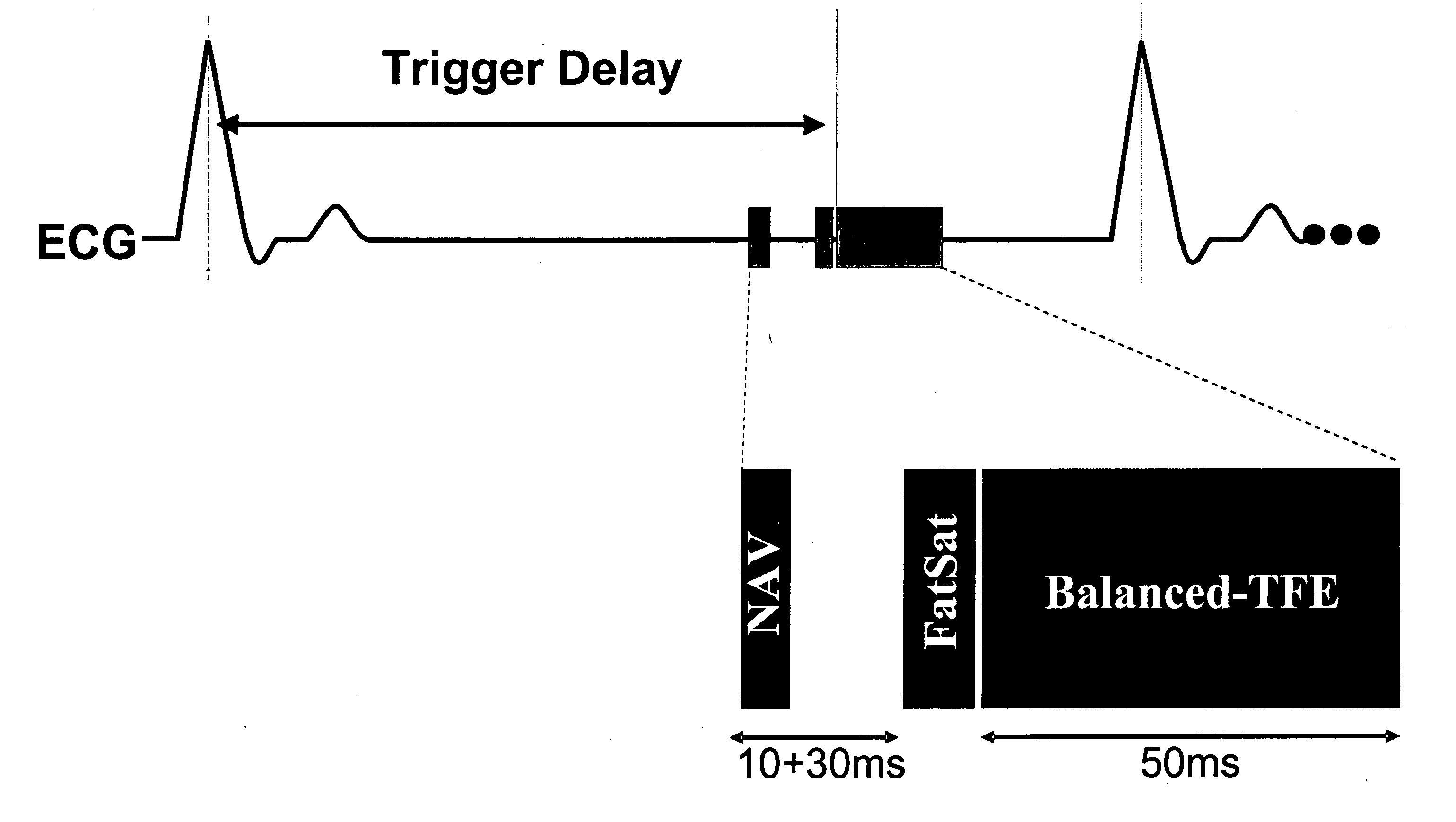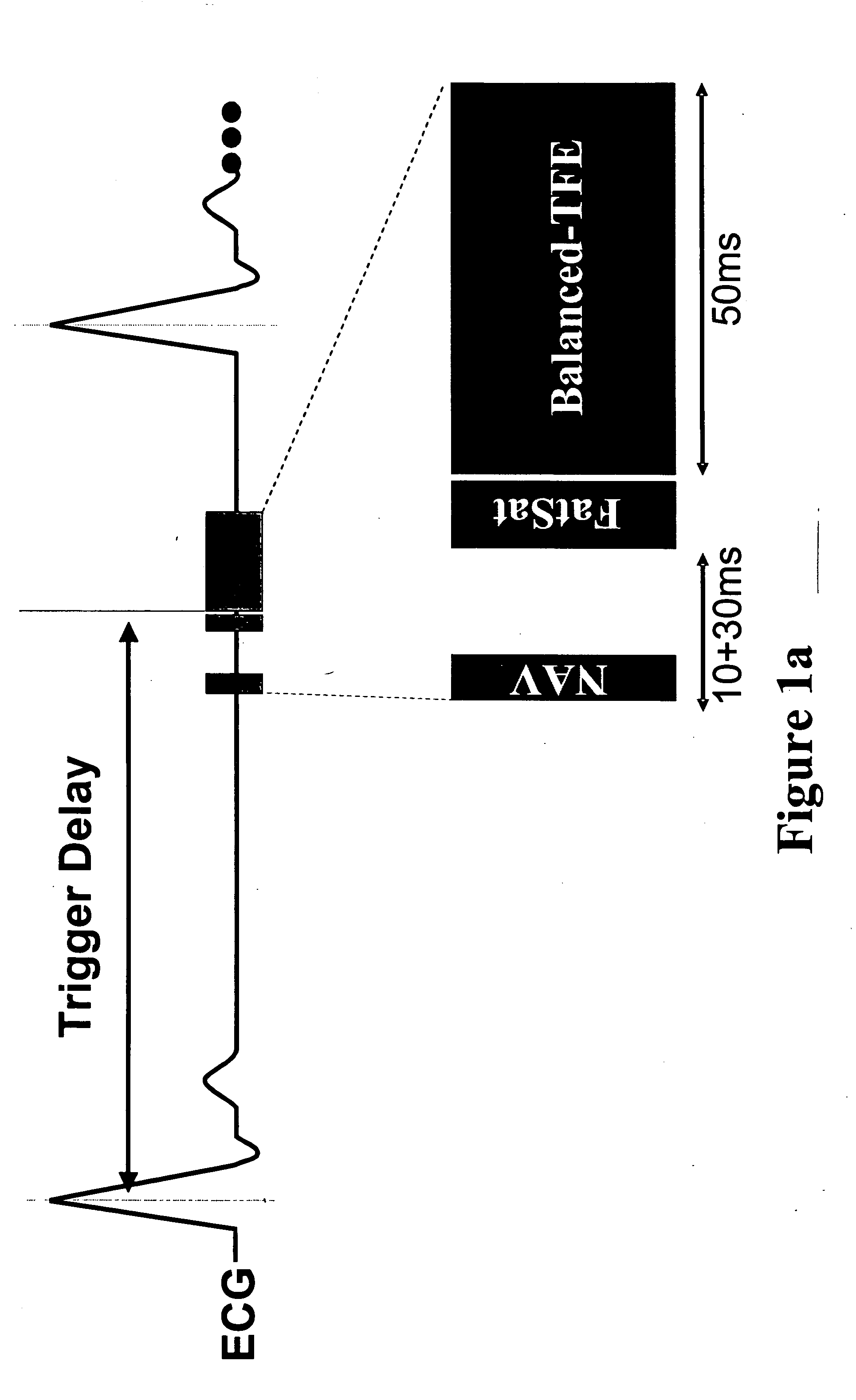Methods of cardiothoracic imaging - (MET-30)
a cardiothoracic and pulmonary vein technology, applied in the field of magnetic resonance imaging, can solve the problems of difficult imaging of thrombosis or infarct, phase errors and ghosting in the mr image, and increase the noise in the image, so as to facilitate the improvement of contrast and resolution of the stationary targ
- Summary
- Abstract
- Description
- Claims
- Application Information
AI Technical Summary
Benefits of technology
Problems solved by technology
Method used
Image
Examples
example 1
Coronary MR Angiography and Coronary Thrombus Imaging with Cardiac Triggering and Navigator Gating
Free-breathing coronary MR angiography and thrombus imaging were performed on six female domestic swine (70-80 kg) in the supine position using an interventional 1.5 T Philips Gyroscan ACS-NT short-bore MRI scanner. The MRI system was equipped with a specially shielded C-arm fluoroscopy unit (Philips Medical Systems, Best, NL), MASTER gradients (23 mT / m, 105 mT / m / ms), an advanced cardiac software patch (INCA2), and a 5-element cardiac synergy receiver coil.
Animal Protocol
After intramusculary premedication with 0.5 ml atropine and 0.2 ml azaperone / kg body weight, an aqueous solution of pentobarbital (1:3) was administered intravenously through one of the ear veins. The animals were intubated and mechanical ventilation was maintained throughout the entire experiment. A 9F sheath (Cordis, Roden, NL) was placed surgically in the right carotid artery.
MRI of Thrombi
The feasibility o...
example 2
Coronary MR Angiography and Coronary Thrombus Imaging (Cardiac Triggering and Navigator Gating)—Systemic Delivery of Contrast Agent
The experiment sought to test the feasibility of direct MR imaging of acute coronary thrombosis using systemic injection of a fibrin-binding contrast agent in an in vivo swine model of coronary thrombosis. Free-breathing coronary MR angiography and thrombus imaging were performed on three female domestic swine (50 kg) in the supine position using a 1.5 T Philips Gyroscan Intera short-bore MRI scanner (Philips Medical Systems, Best, NL). The MRI system was equipped with MASTER gradients (23 mT / m, 105 mT / m / ms), an advanced cardiac software patch (R9.1.1), and a 5-element cardiac synergy receiver coil.
Animal Protocol
After intramusculary premedication with 0.5 ml atropine and 0.2 ml azaperone / kg body weight, an aqueous solution of pentobarbital (1:3) was administered intravenously through one of the ear veins. The animals were intubated and mechanical ...
example 3
Coronary MR Angiography Coronary Thrombus Imaging and Pulmonary Embolism Imaging Using Cardiac Triggering and Navigator Gating—Systemic Delivery of Contrast Agent
The differential diagnosis of acute chest pain is challenging, particularly in patients with normal ECG, and may include coronary thrombosis and / or pulmonary emboli. The aim of this study was the investigation of a fibrin-specific contrast agent (as described in Example 1) for molecular targeted imaging of coronary thrombosis and pulmonary emboli.
Animal Protocol
Coronary thrombus and pulmonary embolus MR imaging were performed on 7 healthy swine (48-52 kg BW). After premedication with 0.5 ml IM atropine, 0.2 ml IM azaperone / kg bodyweight, and 0.1 ml ketamine / kg bodyweight, an aqueous solution of pentobarbital (1:3) was administered intravenously via an ear vein as needed. The animals were intubated and mechanical ventilation was maintained throughout the entire experiment. A 9F sheath (Cordis, Roden, NL) was placed sur...
PUM
| Property | Measurement | Unit |
|---|---|---|
| time | aaaaa | aaaaa |
| dissociation constant | aaaaa | aaaaa |
| dissociation constant | aaaaa | aaaaa |
Abstract
Description
Claims
Application Information
 Login to View More
Login to View More - R&D
- Intellectual Property
- Life Sciences
- Materials
- Tech Scout
- Unparalleled Data Quality
- Higher Quality Content
- 60% Fewer Hallucinations
Browse by: Latest US Patents, China's latest patents, Technical Efficacy Thesaurus, Application Domain, Technology Topic, Popular Technical Reports.
© 2025 PatSnap. All rights reserved.Legal|Privacy policy|Modern Slavery Act Transparency Statement|Sitemap|About US| Contact US: help@patsnap.com



